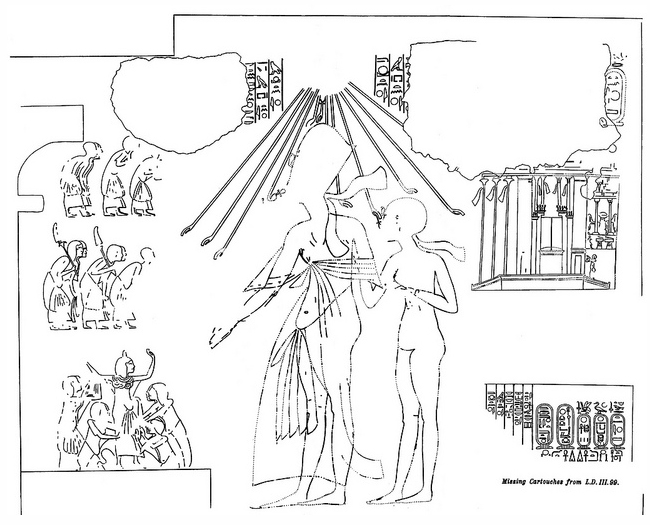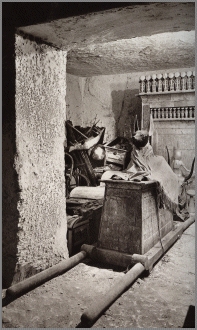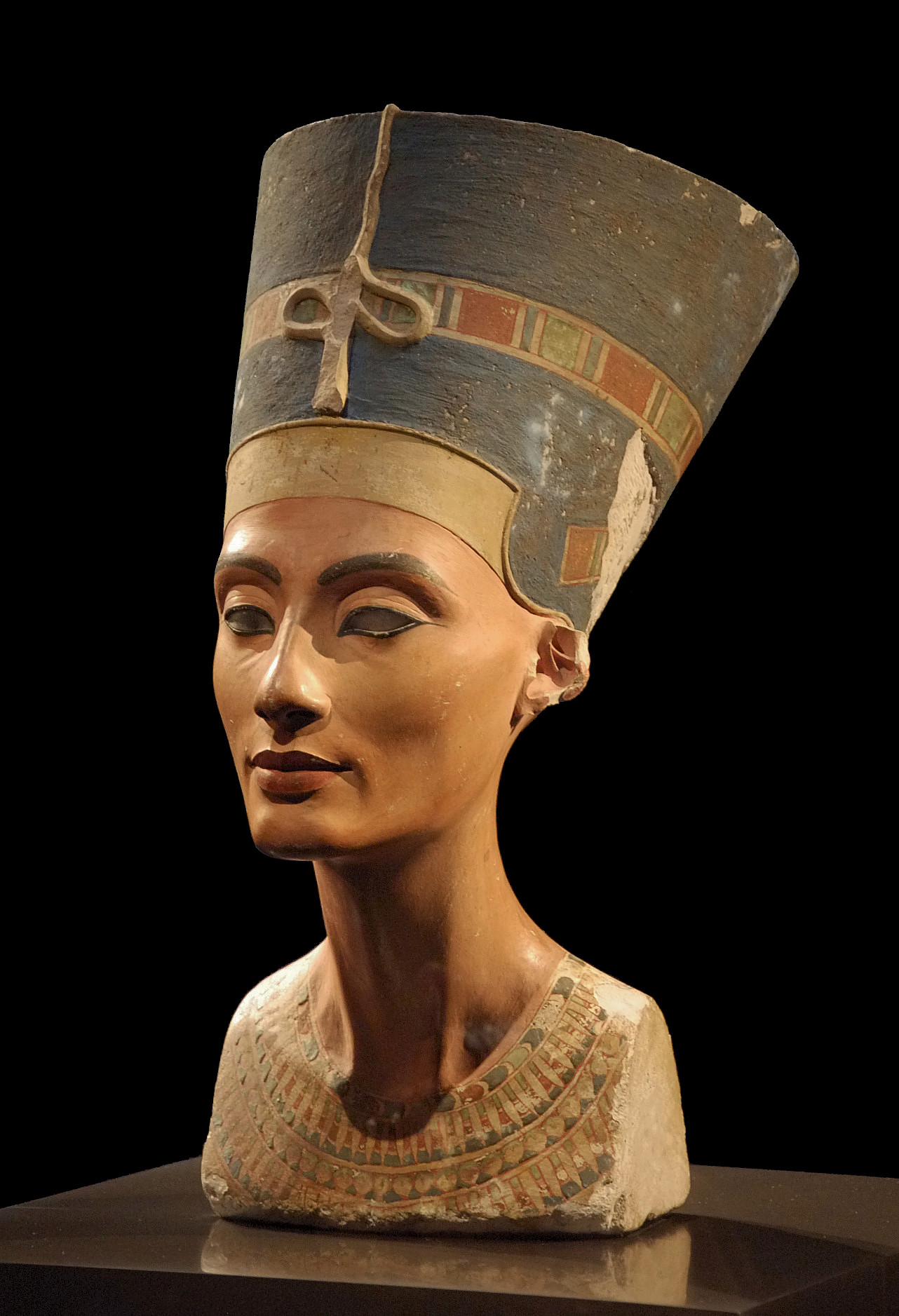|
Tutankhamun
Tutankhamun or Tutankhamen, (; ), was an Egyptian pharaoh who ruled during the late Eighteenth Dynasty of Egypt, Eighteenth Dynasty of ancient Egypt. Born Tutankhaten, he instituted the restoration of the traditional polytheistic form of ancient Egyptian religion, undoing a previous shift to the religion known as Atenism. Tutankhamun's reign is considered one of the greatest restoration periods in ancient Egyptian history. His endowments and restorations of cults were recorded on what is today known as the Restoration Stela. The cult of the god Amun at Thebes, Egypt, Thebes was restored to prominence, and the royal couple changed their names to "Tutankhamun" and "Ankhesenamun", replacing the -aten suffix. He also moved the royal court from Akhenaten's capital, Amarna, back to Memphis, Egypt, Memphis almost immediately on his accession to the kingship. He reestablished diplomatic relations with the Mitanni and carried out military campaigns in Nubia and the Near East. Tutankh ... [...More Info...] [...Related Items...] OR: [Wikipedia] [Google] [Baidu] |
Tomb Of Tutankhamun
The tomb of Tutankhamun (reigned ), a pharaoh of the Eighteenth Dynasty of Egypt, Eighteenth Dynasty of ancient Egypt, is located in the Valley of the Kings. The tomb, also known by its List of burials in the Valley of the Kings, tomb number KV62, consists of four chambers and an entrance staircase and corridor. It is smaller and less extensively decorated than other Egyptian royal tombs of its time, and it probably originated as a tomb for a non-royal individual that was adapted for Tutankhamun's use after his premature death. Like other pharaohs, Tutankhamun was buried with a wide variety of funerary objects and personal possessions, such as coffins, furniture, clothing and jewelry, though in the unusually limited space these goods had to be densely packed. Robbers entered the tomb twice in the years immediately following the burial, but Tutankhamun's mummy and most of the burial goods remained intact. The tomb's low position, dug into the floor of the valley, allowed its entra ... [...More Info...] [...Related Items...] OR: [Wikipedia] [Google] [Baidu] |
Neferneferuaten
Ankhkheperure-Merit-Neferkheperure/Waenre/Aten Neferneferuaten (), or "Neferneferuaten", is the name of a queen regnant ('female pharaoh, king') of ancient Egypt who reigned in her own right near the end of the Amarna Period during the Eighteenth dynasty of Egypt, Eighteenth Dynasty. Her name features feminine Grammatical gender, gender traces; and one of her epithets was ''Akhet-en-hyes'' ("Effective for her husband"). This epithet also features in one version of her Nomen (ancient Egypt), nomen (birth name) cartouche. (See Ancient Egyptian royal titulary.) She is distinguished from the king Smenkhkare, with whom she shared the prenomen (throne name) ''Ankhkheperure'', by the presence of epithets in both cartouches. It has been suggested that she was in fact Smenkhkare's wife Meritaten or his predecessor Akhenaten's widow Nefertiti. The Golden Nut Pectoral (Carter no. 261p1) The golden Nut Pectoral (Ancient Egypt), pectoral (Carter no. 261p1) was also reused for the funeral o ... [...More Info...] [...Related Items...] OR: [Wikipedia] [Google] [Baidu] |
Mask Of Tutankhamun
The mask of Tutankhamun is a gold funerary mask that belonged to Tutankhamun, who reigned over the New Kingdom of Egypt from 1332 BC to 1323 BC, during the Eighteenth Dynasty. After being buried with Tutankhamun's mummy for over 3,000 years, it was found in 1925 following the discovery of Tutankhamun's tomb three years earlier by the British archaeologist Howard Carter at the Valley of the Kings. Since then, it has been on display at the Egyptian Museum in the city of Cairo. Bearing the likeness of Osiris, the Egyptian god of the afterlife, the mask is tall, weighs over or 321.5 troy ounces, and is decorated with semi-precious stones. A spell from the '' Book of the Dead'' is inscribed in Egyptian hieroglyphs on its shoulders. In 2015, it had to be restored after its plaited beard fell off and was hastily glued back on by museum workers. According to the British Egyptologist and archaeologist Nicholas Reeves, the mask is "not only the quintessential image from Tuta ... [...More Info...] [...Related Items...] OR: [Wikipedia] [Google] [Baidu] |
Akhenaten
Akhenaten (pronounced ), also spelled Akhenaton or Echnaton ( ''ʾŪḫə-nə-yātəy'', , meaning 'Effective for the Aten'), was an ancient Egyptian pharaoh reigning or 1351–1334 BC, the tenth ruler of the Eighteenth Dynasty of Egypt, Eighteenth Dynasty. Before the fifth year of his reign, he was known as Amenhotep IV (, meaning "Amun is satisfied", Hellenized as ''Amenophis IV''). As a pharaoh, Akhenaten is noted for abandoning traditional ancient Egyptian religion of polytheism and introducing Atenism, or worship centered around Aten. The views of Egyptologists differ as to whether the religious policy was absolutely monotheism, monotheistic, or whether it was monolatristic, religious syncretism, syncretistic, or henotheistic. This culture shift away from traditional religion was reversed after his death. Akhenaten's monuments were dismantled and hidden, his statues were destroyed, and his name Damnatio memoriae, excluded from regnal list, lists of rulers compiled by lat ... [...More Info...] [...Related Items...] OR: [Wikipedia] [Google] [Baidu] |
Ankhesenamun
Ankhesenamun (, "Her Life Is of Amun"; c. 1348 or c. 1342 – after 1322 BC) was an ancient Egyptian queen who lived during the Eighteenth Dynasty of Egypt, 18th Dynasty of Egypt. Born Ankhesenpaaten (, "she lives for the Aten"), she was the third of six known daughters of the Egyptian Pharaoh Akhenaten and his Great Royal Wife Nefertiti. She became the Great Royal Wife of Tutankhamun. The change in her name reflects the changes in ancient Egyptian religion during her lifetime after her father's death. Her youth is well documented in the ancient reliefs and paintings of the reign of her parents. Ankhesenamun was well documented as being the Great Royal Wife of Pharaoh Tutankhamun. Initially, she may have been married to her father and it is possible that, upon the death of Tutankhamun, she was married briefly to Tutankhamun's successor, Ay (pharaoh), Ay, who is believed by some to be her maternal grandfather. DNA test results on mummies discovered in KV21 were released in F ... [...More Info...] [...Related Items...] OR: [Wikipedia] [Google] [Baidu] |
Ay (pharaoh)
Ay was the penultimate pharaoh of ancient Egypt's Eighteenth Dynasty of Egypt, 18th Dynasty. He held the throne of Egypt for a brief four-year period in the late 14th century BC. Prior to his rule, he was a close advisor to two, and perhaps three, other pharaohs of the dynasty. It is speculated that he was the power behind the throne during child ruler Tutankhamun's reign, although there is no evidence for this aside from Tutankhamun's youthfulness. His ''Prenomen (Ancient Egypt), prenomen'' ''Kheperkheperure'' means "Everlasting are the Manifestations of Ra", while his ''nomen (Ancient Egypt), nomen'' ''Ay it-netjer'' reads as "Ay, Father of the God". Records and monuments that can be clearly attributed to Ay are rare, both because his reign was short and because his successor, Horemheb, instigated a campaign of ''damnatio memoriae'' against him and the other pharaohs associated with the unpopular Amarna Period. Origins and family Ay is believed to have been from Akhmim. During ... [...More Info...] [...Related Items...] OR: [Wikipedia] [Google] [Baidu] |
Restoration Stela
The Restoration Stela, also known as the Restoration Stela of Tutankhamun, is an ancient Egyptian text from the reign of pharaoh Tutankhamun decreeing the Religion in politics, religiopolitical countermand of the Atenism religion of the pharaoh Akhenaten. It is a record of the governmental policy change wherein Atenism was officially repealed, and the original, Ancient Egyptian religion, indigenous religion of ancient Egypt was reinstated. It was discovered in 1905 by Egypologist Georges Legrain in fragmented condition. In overview, the writing details the deplorable conditions of the polytheistic religious institutions and society overall during the Atenism era, and how the pharaoh Tutankhamun enacted a system of revitalizing those religious institutions and reharmonizing society. These policies included various architectural and employment renovations. Egyptologist Ray Johnson referred to Tutankhamun's reign as "one of the greatest periods of restoration in the history of Egypt ... [...More Info...] [...Related Items...] OR: [Wikipedia] [Google] [Baidu] |
Smenkhkare
Smenkhkare (alternatively romanized Smenkhare, Smenkare, or Smenkhkara; meaning "Vigorous is the soul of Re") was an ancient Egyptian pharaoh of unknown background who lived and ruled during the Amarna Period of the 18th Dynasty. Smenkhkare was husband to Meritaten, the daughter of his likely co-regent, Akhenaten. Since the Amarna period was subject to a large-scale condemnation of memory by later pharaohs, very little can be said of Smenkhkare with certainty, and he has hence been subject to immense speculation. Origin and family Smenkhkare's origins are unknown. It is assumed he was a member of the royal family, likely either a brother or son of the pharaoh Akhenaten. If he is Akhenaten's brother, his mother was likely either Tiye or Sitamun. If a son of Akhenaten, he was presumably an older brother of Tutankhamun, as he succeeded the throne ahead of him; his mother was likely an unknown, lesser wife. An alternative suggestion, based on objects from the tomb of Tutankhamun ... [...More Info...] [...Related Items...] OR: [Wikipedia] [Google] [Baidu] |
317a And 317b Mummies
Mummies 317a and 317b are the remains of two infant daughters of Tutankhamun, a pharaoh of the Eighteenth Dynasty of Egypt. Their mother, who has been tentatively identified through DNA testing as the mummy KV21A, is presumed to be Ankhesenamun, his only known wife. 317a was born prematurely at 5–6 months' gestation, and 317b was born at or near full term. They are assumed to have been stillborn or died shortly after birth. They were buried in their father's tomb in the Valley of the Kings, which was discovered by the Egyptologist Howard Carter in 1922. Their bodies were mummified and wrapped in the same style as high-status adults and 317a was fitted with a gilded mummy mask; 317b's mask was too small for her and was found in 1907 among the leftovers from Tutankhamun's mummification and funerary feast cached in KV54. Each girl was buried in miniature two-coffin sets of the same design used by nobility. Both babies were unnamed, as the coffin inscriptions call them onl ... [...More Info...] [...Related Items...] OR: [Wikipedia] [Google] [Baidu] |
Eighteenth Dynasty Of Egypt
The Eighteenth Dynasty of Egypt (notated Dynasty XVIII, alternatively 18th Dynasty or Dynasty 18) is classified as the first dynasty of the New Kingdom of Egypt, the era in which ancient Egypt achieved the peak of its power. The Eighteenth Dynasty spanned the period from 1550/1549 to 1292 BC. This dynasty is also known as the Thutmoside Dynasty for the four pharaohs named Thutmose. Several of Egypt's most famous pharaohs were from the Eighteenth Dynasty, including Tutankhamun. Other famous pharaohs of the dynasty include Hatshepsut (c. 1479 BC–1458 BC), the longest-reigning woman pharaoh of an indigenous dynasty, and Akhenaten (c. 1353–1336 BC), the "heretic pharaoh", with his Great Royal Wife, Nefertiti. The Eighteenth Dynasty is unique among Egyptian dynasties in that it had two Queen regnant, queens regnant, women who ruled as sole pharaoh: Hatshepsut and Neferneferuaten, usually identified as Nefertiti. History Early Dynasty XVIII Dynasty XVIII was founded by Ahmo ... [...More Info...] [...Related Items...] OR: [Wikipedia] [Google] [Baidu] |
KV55
KV55 is a tomb in the Valley of the Kings in Egypt. It was discovered by Edward R. Ayrton in 1907 while he was working in the Valley for Theodore M. Davis. It has long been speculated, as well as much disputed, that the body found in this tomb was that of the famous king, Akhenaten, who moved the capital to Akhetaten (modern-day Amarna). The results of genetic and other scientific tests published in February 2010 have confirmed that the person buried there was both the son of Amenhotep III and the father of Tutankhamun. Furthermore, the study established that the age of this person at the time of his death was consistent with that of Akhenaten, thereby making it almost certain that it is Akhenaten's body.Hawass, Zahi et al. "Ancestry and Pathology in King Tutankhamun's Family" ''The Journal of the American Medical Association'' (2010) p. 644 However, a growing body of work soon began to appear to dispute the assessment of the age of the mummy and the identification of KV55 as A ... [...More Info...] [...Related Items...] OR: [Wikipedia] [Google] [Baidu] |
Egyptian Museum
The Museum of Egyptian Antiquities, commonly known as the Egyptian Museum (, Egyptian Arabic: ) (also called the Cairo Museum), located in Cairo, Egypt, houses the largest collection of Ancient Egypt, Egyptian antiquities in the world. It houses over 120,000 items, with a representative amount on display. Located in Tahrir Square in a building built in 1901, it is the list of largest art museums, largest museum in Africa. Among its masterpieces are Pharaoh Tutankhamun's treasure, including its iconic Mask of Tutankhamun, gold burial mask, widely considered one of the best-known works of art in the world and a prominent symbol of ancient Egypt. History The Egyptian Museum of Antiquities contains many important pieces of ancient Egyptian history. It houses the world's largest collection of Pharaonic antiquities. The Egyptian government established the museum built in 1835 near the Azbakeya, Ezbekieh Garden and later moved to the Cairo Citadel. In 1855, Maximilian I of Mexico, ... [...More Info...] [...Related Items...] OR: [Wikipedia] [Google] [Baidu] |








